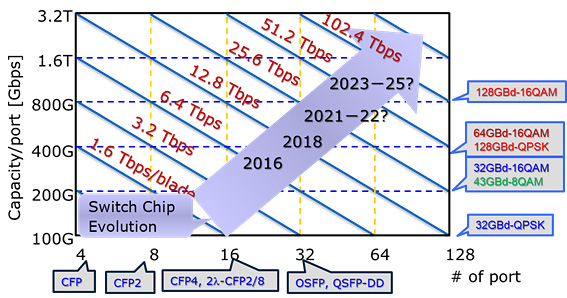Coherent Everywhere!
February 9, 2021
From this year, we will create a technial blog to introduce NTT Electronics products and technology. In this [Tech Info], we will highlight the technology background and product features. The first [Tech Info] discusses trends in the coherent optical communication market and related technologies.
Coherent Everywhere!
Industry considers expanding coherent from long-haul to short reach networks
By Atul Srivastava
Modern fiber optic communication infrastructure is revolutionized by the recent advances in coherent transmission systems, which are being deployed to address the exponentially growing demand for bandwidth in telecommunication and datacenter networks. Currently, 100 to 600 Gb/s data rate WDM systems are being deployed in the terrestrial and undersea fiber optic networks supporting 10-20 Tb/s capacity per fiber. The advances in highly integrated photonic devices and the next generation CMOS based high performance DSPs has made it feasible to introduce coherent systems in the datacenter networks which need to support the increasing I/O data rates for the switch ASICs* 1. The developments in the new CMOS based DSP technology and significant progress in the photonic integrated devices including the silicon photonics are enabling small form factor pluggable modules for 400 Gb/s and 600 Gb/s WDM interconnects for the datacenters. Higher data rate 400 Gb/s ZR modules are starting deployment in the datacenter interconnects standardized at the Optical Internetworking Forum (OIF). The next generation small form factor OSFP and QSFP-DD pluggable 400G modules are designed to provide I/O for the next generation switch ASICs with 12.8Tbps and higher capacity.
OpenZR+ MSA recently announced that using higher gain oFEC, standardized at OpenROADM MSA, the same module can be used for longer reach applications such as the regional and long-haul interconnects in hyperscale data center applications, and also supports service provider requirements. OpenZR+ enables network operators to address 400G regional interconnects beyond 1,000km and even long-haul requirements with 200G reaches beyond 2,500km using pluggable modules based on interoperable modes* 2.
Standardization of the next generation 800G modules has been initiated for possible application in ZR and 2-10km distances. There is debate about the use of direct detection PAM4 solution for 2-10km reach. There are concerns about the link performance and power dissipation for PAM4. Coherent technology can surely meet the performance with wide margin for these links but the cost of DSP is still a major issue. For 800G links, both formats have a chance of success, however for higher data rates at 1.6T coherent seems to be the only feasible solution. If successful, at 800G and higher data rates, coherent will make inroads into shorter reach links including high volume links inside the datacenters.

Fig. 1. Evolution of I/O Capacity per port vs. the number of transceiver modules per line card for achieving full Switch throughput capacity.
Figure 1 shows the relationship between the capacity per blade and the number of module ports per blade as the switch ASIC capacity has evolved in last few years. In order to keep up with the switch ASIC I/O capacity demand, both the data rate of pluggable transceiver port and the number of ports per blade need to increase. Higher data rate pluggable transceivers have shrunk in size and are using a higher baud rate and/or advanced modulation formats. The OIF published an implementation agreement on coherent transceivers based on the C form-factor pluggable2 (CFP2)-analog coherent optics (ACO) form factor* 3.
CFP2 transceivers supporting 200 Gb/s are now commercially available, which corresponds to 1.6 Tb/s/blade in Figure 1, assuming 8 CFP2 transceivers per blade. In order to further reduce the size of the future transceiver modules, new optical device technologies with higher integration have to be employed. In addition, the power dissipation of DSPs needs to be reduced to manage the cooling of the blade line card. In general, the size of the module is determined by the level of optical integration, whereas power dissipation is governed by the electronic devices such as the DSP* 4.
In next [Tech Info], We will show you the technology to implement a small form factor module for telecommunications carriers and data center networks. In particular, We would like to give you an overview of recent advances in two key technologies: coherent DSP technology and silicon photonics integrated coherent subassembly (COSA) devices.
References
- *1
- Brad Booth, "Consortium for On-Board Optics: 100G/400G/800G Optics," Market Focus Presentation (2018).
- *2
- http://openzrplus.org/documents/ Whitepaper: "OpenZR+ 400G Digital Coherent Optics for Multi-Haul"
- *3
- http://www.oiforum.com/wp-content/uploads/OIF-CFP2-ACO-01.0.pdf
- *4
- A. Srivastava and H. Onaka, "Coherent Technologies Revolutionize Fiber Optic Communication," in Proc. Photonics, (2018).